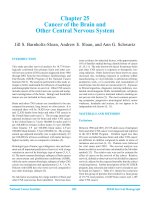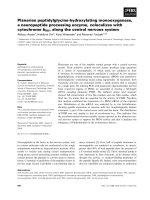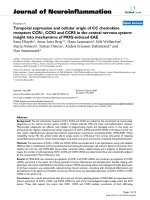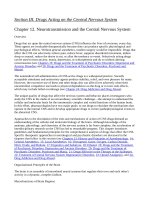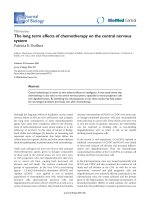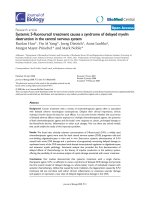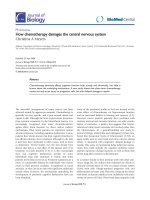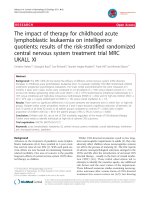Physiology: The central nervous system
Bạn đang xem bản rút gọn của tài liệu. Xem và tải ngay bản đầy đủ của tài liệu tại đây (9.22 MB, 36 trang )
Physiology
The Central
Nervous System
www.cambodiamed.com
CNS
• Consists of:
www.cambodiamed.com
• Brain.
• Spinal cord.
• Receives input from
sensory neurons.
• Directs activity of motor
neurons.
• Association neurons
maintain homeostasis in
the internal environment.
www.cambodiamed.com
Embryonic Development
• Groove appears in ectoderm to fuse to form neural tube by 20th
day after conception. Neural tube eventually forms the CNS.
• During 5th week, modified:
• Forebrain: telencephalon and diencephalon.
• Midbrain: unchanged.
• Hindbrain: metencephalon and myelencephalon.
• Part of ectoderm where fusion occurs becomes neural crest.
• Neural crest forms ganglia of PNS.
www.cambodiamed.com
Embryonic Development
www.cambodiamed.com
www.cambodiamed.com
(continued)
Embryonic Development
(continued)
• Telencephalon grows disproportionately forming 2
the hemispheres of the cerebrum.
• Ventricles and central canal become filled with
cerebral spinal fluid (CSF).
• CNS composed of gray and white matter.
• Gray matter consists of neuron cell bodies and dendrites.
• White matter (myelin) consists of axon tracts.
www.cambodiamed.com
www.cambodiamed.com
Cerebrum
• Only structure of the telencephalon.
• Largest portion of brain (80% mass).
• Responsible for higher mental functions.
• Corpus callosum:
• Major tract of axons that functionally interconnects right
and left cerebral hemispheres.
www.cambodiamed.com
Cerebrum
(continued)
www.cambodiamed.com
Cerebral Cortex
Characterized by numerous convolutions.
◦ Elevated folds: gyri.
◦ Depressed groves: sulci.
Frontal lobe:
◦ Anterior portion of each cerebral hemisphere.
◦ Precentral gyri:
• Contains upper motor neurons.
• Involved in motor control.
Body regions with the greatest number of motor
innervation are represented by largest areas of motor
cortex.
www.cambodiamed.com
Cerebral Cortex
(continued)
www.cambodiamed.com
Cerebral Cortex
(continued)
• Parietal lobe:
• Primary area responsible for perception of somatesthetic
sensation.
• Body regions with highest densities of receptors are
represented by largest areas of sensory cortex.
• Temporal lobe:
• Contain auditory centers that receive sensory fibers from
cochlea.
• Interpretation and association of auditory and visual
information.
www.cambodiamed.com
Cerebral Cortex
(continued)
• Occipital Lobe:
• Primary area responsible for vision and coordination of
eye movements.
• Insula:
• Implicated in memory encoding.
• Integration of sensory information with visceral
responses.
• Coordinated cardiovascular response to stress.
www.cambodiamed.com
Visualizing the Brain
• X-ray computed tomography (CT):
• Complex computer manipulations of data obtained from x-ray
absorption by tissues of different densities.
• Soft tissue.
• Positron-emission tomography (PET):
• Radioisotopes that emit positrons are injected into blood stream.
• Collision of positron and electron result in emission of gamma rays.
• Pinpoint brain cells that are most active.
• Brain metabolism, drug distribution.
• Magnetic resonance imaging (MRI):
• Protons (H+) respond to magnetic field, which align the protons.
• Emit a radio-wave signal when stimulated.
• Brain function.
www.cambodiamed.com
Electroencephalogram (EEG)
• Measures synaptic
potentials produced at
cell bodies and
dendrites.
• Create electrical
currents.
• Used clinically do
diagnose epilepsy and
brain death.
www.cambodiamed.com
EEG Patterns
• Alpha:
▫ Recorded from parietal and occipital regions.
Person is awake, relaxed, with eyes closed.
10-12 cycles/sec.
• Beta:
▫ Strongest from frontal lobes near precentral gyrus.
Produced by visual stimuli and mental activity.
Evoked activity.
13-25 cycles/sec.
• Theta:
▫ Emitted from temporal and occipital lobes.
Common in newborn.
Adult indicates severe emotional stress.
5-8 cycles/sec.
• Delta:
▫ Emitted in a general pattern.
Common during sleep and awake infant.
In awake adult indicate brain damage.
1-5 cycles/sec.
www.cambodiamed.com
EEG Sleep Patterns
• 2 types of EEG patterns during sleep:
• REM (rapid eye movement):
• Dreams occur.
• Low-amplitude, high-frequency oscillations.
• Similar to wakefulness (beta waves).
• Non-Rem (resting):
• High-amplitude, low-frequency waves (delta waves).
• Superimposed on these are sleep spindles:
• Waxing and waning bursts of 7-14 cycles/sec.
• Last for 1-3 sec.
www.cambodiamed.com
Basal Nuclei (basal ganglia)
• Masses of gray matter
composed of neuronal cell
bodies located deep within
white matter.
• Contain:
• Corpus striatum:
• Caudate nucleus.
• Lentiform nucleus:
• Putman and globus
pallidus.
• Functions in the control of
voluntary movements.
www.cambodiamed.com
Cerebral Lateralization
• Cerebral dominance:
▫ Specialization of one
hemisphere.
• Left hemisphere:
▫ More adept in language and
analytical abilities.
▫ Damage:
Severe speech problems.
• Right hemisphere:
▫ Most adept at visuospatial
tasks.
▫ Damage:
Difficulty finding way around
house.
www.cambodiamed.com
Language
• Broca’s area:
• Involves articulation of speech.
• In damage, comprehension of speech in unimpaired.
• Wernicke’s area:
• Involves language comprehension.
• In damage, language comprehension is destroyed, but speech is
rapid without any meaning.
• Angular gyrus:
• Center of integration of auditory, visual, and somatesthetic
information.
• Damage produces aphasias.
• Arcuate fasciculus:
• To speak intelligibly, words originating in Wernicke’s area must be
sent to Broca’s area.
• Broca’s area sends
fibers to the motor cortex which directly controls
www.cambodiamed.com
the musculature of speech.
Emotion and Motivation
• Important in the neural basis of
emotional states are
hypothalamus and limbic
system.
• Limbic system:
▫ Group of forebrain nuclei and
fiber tracts that form a ring
around the brain stem.
Center for basic emotional drives.
• Closed circuit (Papez circuit):
▫ Fornix connects hippocampus
to hypothalamus, which projects
to the thalamus which sends
fibers back to limbic system.
www.cambodiamed.com
Emotion and Motivation
(continued)
• Areas or the hypothalamus and limbic system are
involved in feelings and behaviors.
• Aggression:
• Amygdala and hypothalamus.
• Fear:
• Amygdala and hypothalamus.
• Feeding:
• Hypothalamus (feeding and satiety centers).
• Sexual drive and behavior:
• Hypothalamus and limbic system.
• Goal directed behavior (reward and punishment):
• Hypothalamus and frontal cortex.
www.cambodiamed.com
Memory
• Short-term:
• Memory of recent events.
• Medial temporal lobe:
• Consolidates short term into long term memory.
• Hippocampus is critical component of memory.
• Acquisition of new information, facts and events
requires both the medial temporal lobe and
hippocampus.
www.cambodiamed.com
Long-Term Memory
• Consolidation of short-term memory into long-term
memory.
• Requires activation of genes, leading to protein synthesis and
formation of new synaptic connections.
• Altered postsynaptic growth of dendritic spines in area of contact.
• Cerebral cortex stores factual information:
• Visual memories lateralized to left hemisphere.
• Visuospatial information lateralized to right hemisphere.
• Prefrontal lobes:
• Involved in performing exact mathematical calculations.
• Complex, problem-solving and planning activities.
www.cambodiamed.com
Long-Term Potentiation
• Type of synaptic learning.
▫ Synapses that are 1st stimulated at high frequency will
subsequently exhibit increased excitability.
• In hippocampus, glutamate is NT.
▫ Requires activation of the NMDA receptors for glutamate.
Glutamate and glycine or D-serine binding and partial
depolarization are required for opening of channels for Ca2+ and Na+.
• May also involve presynaptic changes:
▫ Binding of glutamate to NMDA receptors and simultaneous
depolarization, open receptor channels for Ca2+.
Ca2+ causes long-term potentiation in postsynaptic neuron, release of
NO from postsynaptic neuron.
NO acts as a retrograde messenger, causing release of NT.
www.cambodiamed.com
Neuronal Stem Cells in Learning
and Memory
• Neural stem cells:
• Cells that both renew themselves through mitosis and
produce differentiated neurons and neuroglia.
• Hippocampus has been shown to contain stem
cells (required for long-term memory).
• Neurogenesis:
• Production of new neurons.
• Indirect evidence that links neuogenesis in
hippocampus with learning and memory.
www.cambodiamed.com
Thalamus and Epithalamus
• Thalamus:
▫ Composes 4/5 of the diencephalon.
▫ Forms most of the walls of the 3rd ventricle.
▫ Acts as relay center through which all sensory information (except
olfactory) passes to the cerebrum.
Lateral geniculate nuclei:
Relay visual information.
Medial geniculate nuclei:
Relay auditory information.
Intralaminar nuclei:
Activated by many sensory modalities.
Projects to many areas.
▫ Promotes alertness and arousal from sleep.
• Epithalamus contains:
▫ Choroid plexus where CSF is formed.
▫ Pineal gland which secretes melatonin.
www.cambodiamed.com
